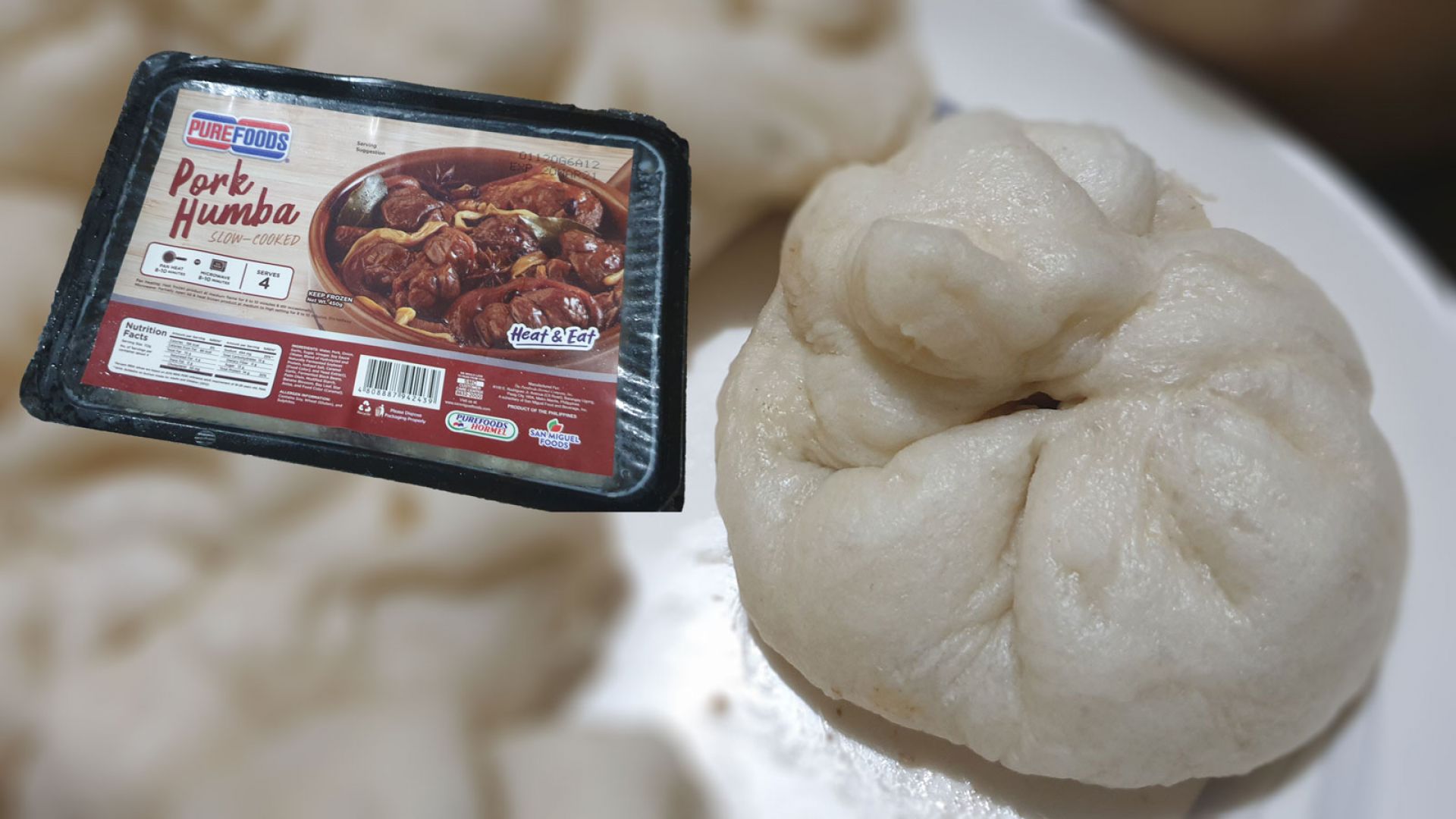 Purefoods Ready to Eat Viands has 9 different variants and I decided to start with something easy … Pork Humba. For those who are unfamiliar with Pork Humba, it is a sweet and savory dish. This (in my opinion) makes it a perfect filling for siopao, as it will be reminiscent of Pork Asado.
Purefoods Ready to Eat Viands has 9 different variants and I decided to start with something easy … Pork Humba. For those who are unfamiliar with Pork Humba, it is a sweet and savory dish. This (in my opinion) makes it a perfect filling for siopao, as it will be reminiscent of Pork Asado.
Siopao (sometimes called steamed dumplings) is best known as a Chinese snack, often served with noodle soup.
It’s as easy as 1-2-3
 Purefoods Ready to Eat Viands are truly easy to serve. it only takes less than 10 minutes to feed our family.
Purefoods Ready to Eat Viands are truly easy to serve. it only takes less than 10 minutes to feed our family.
- Take your selected Purefoods Ready to Eat viand from the freezer.
- Thaw it out in the chiller or drainboard.
- Open the package and pour its contents into a pan and heat for 8 to 10 minutes.
It’s that easy! Usually served with hot rice. 🙂
This was the recipe provided by HomefoodiePH and Purefoods for Humba Pao:
Ingredients:
- 1 pack Purefoods Ready to Eat
- 6 pieces store-bought cua pao, reheated to package instructions
- 6 tbsp. chopped peanuts
- 3 tbsp. coriander (wansoy) leaves
Instructions:
- Slice humba into 1/4 inch thick slices. Reheat in a pan with the sauce.
- Assemble by placing a few slices of humba in the pao and drizzling with humba sauce. Serve with peanuts and coriander.
That recipe makes 6 servings.
What I ended up doing
I didn’t have any cua pao and I didn’t want to have to go to the grocery just to buy some. But I did have the ingredients to make siopao buns, so that is what I did. This is the recipe that I used.
Siopao bun
This is the recipe for making just the buns without the filling. You can fill the buns with any kind of food really. It could be savory, or sweet, or both!
- 1 cup warm water
- 2 tsp dry instant yeast
- 2 tbsp sugar
- 1/2 tsp salt
- 4 cups all-purpose flour
- 2 tsp baking powder
- 1/2 cups sugar
- 2 tbsp oil use a neutral oil
- 1 kalamansi (juice only)
- a little more flour for dusting when kneading
Prepping
- Combine the water, yeast, 2 tbsp. sugar, and salt and mix. Make sure that the milk is not too hot or the yeast will die. Let it sit for about 10 minutes. You will know the yeast is alive and ready if it bubbles up.
- In a mixing bowl combine the flour, baking powder, remaining sugar, oil, and kalamansi.
- Pour the yeast mixture into the flour mixture and mix until fully blended. Knead until it turns into a dough that is smooth and not sticky.
- Cover the bowl with a clean cloth and set it aside for 1 hour or until it doubles in size.
Assembling the pao
- After an hour, take the dough out of the bowl and put it on your rolling mat or board and knead it a little more then roll it into a log and divide it into 12 equal (or as equal as you can make them) parts, and set them aside on a tray or mat without touching each other. You can roll them into balls for easier handling later. Cover with a cloth until you need them and let them rest for 30 minutes. The dough will rise even more.

- Take one part and knead it and make a ball. Dust it with flour and flatten it with your palm then roll it into a flat disk (circle) making sure the center is thicker than the sides as the middle will hold the filling.
- Place 1 to 2 spoons of the filling in the middle of the disk and then gently lift the edges to the middle in folds and then pinch and twist.
- Take a small piece of baking paper (or waxed paper) and put the bun on it. This will prevent the filling from leaking out. Place the assembled bun on a plate or tray until you will cook it.
- Repeat from step 2 of “assembling the pao” for the remaining dough balls.
It’s time to steam
- Place your steamer on the stove. Make sure there is water underneath or it won’t steam. 🙂 Turn it on and wait a few minutes before putting the buns in
- In the steaming tray place enough buns without touching. Keep in mind that the buns will still expand. It is likely that not all the buns will fit in one layer so you will need to either put another layer or just cook a second or third batch. Steam your buns for 20 minutes then turn off the stove and let the buns sit in the steamer for another 5 minutes before removing them.
- You can fill these buns with anything you want. Keep in mind, it is really just bread. 🙂
- If you are cooking more than one layer of the buns, keep in mind that they will not cook the same because one layer will be hotter than the other. In my experience, the buns at the bottom “blossom” better than the ones on the upper layers.
- This recipe is based on research from 2 or 3 recipe sites and I adjusted based on my available ingredients and the amount of effort I was willing to put into it. 😀 This is loosely based on the pita recipe I followed last time but instead of grilling the bread, I steamed it.
This is the first time that I made this so while I got it to cook and taste the way it should, I couldn’t get the right technique to pinch it closed consistently, hehe. The next time I make this I will most likely fold the buns into cua pao instead of siopao. 😀
How does the Pork Humba taste?
The Pork Humba ready to eat viand tasted just like pork humba should … savory and sweet at the same time. The meat was just the right level of softness and was anything but tough or dry.
 I will confess that instead of thawing it in the chiller or drainboard, I decided to put it in the pot frozen and thaw it gently on the stove in low heat.
I will confess that instead of thawing it in the chiller or drainboard, I decided to put it in the pot frozen and thaw it gently on the stove in low heat.
I also decided to cut it up with scissors in the pot, instead of cutting it on the board with a knife. This was because I didn’t want to waste any of the sauce.
I didn’t get to use all the humba when I made the paos so what was left I set aside I intend to eat tomorrow for lunch. 🙂
Feedback from the fam
 They loved it! They loved the flavor of the humba and the combination with the siopao bun (phew!) Now I have one more new recipe to add to my repertoire. Thanks for the assist, Purefoods! And thank you, HomefoodiePH for the recipe suggestion. <3
They loved it! They loved the flavor of the humba and the combination with the siopao bun (phew!) Now I have one more new recipe to add to my repertoire. Thanks for the assist, Purefoods! And thank you, HomefoodiePH for the recipe suggestion. <3






